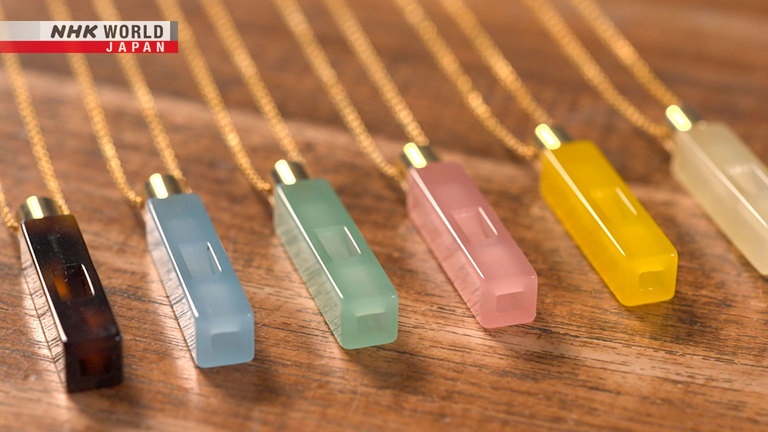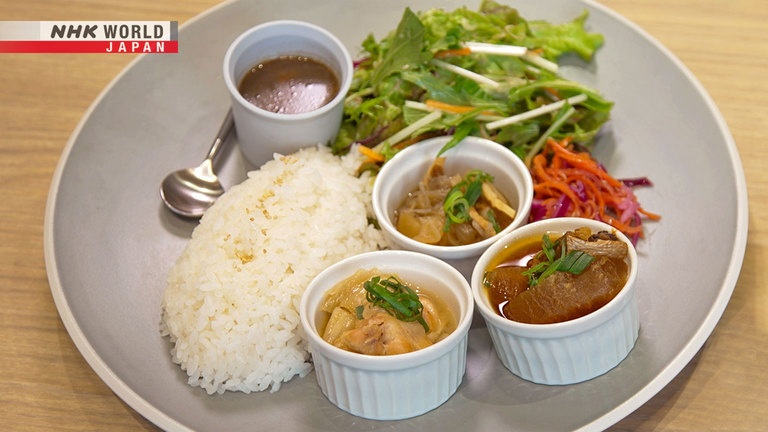Contributing to Disaster Readiness
[SPECIAL EDITION]
This series includes selected stories from BIZ STREAM's signature "On-Site" reports. From an eyewear manufacturer's emergency whistle to survival foods made by a construction hardware supplier, this episode features Japanese companies that have stepped out of their areas of expertise to create disaster readiness products.
*Subtitles and transcripts are available for video segments when viewed on our website.
Contributing to Disaster Readiness


Transcript
Made to be worn as a daily accessory, this emergency whistle was created by an eyewear manufacturer.
And, a construction hardware supplier is now producing a wide range of emergency survival foods
and have even created a cafe to feature them in.
Today's On-Site introduces Japanese companies
that have stepped out of their areas of expertise to create disaster readiness products.
Tsuda Koujun is the president of an eyewear manufacturer that also makes emergency whistles.
The whistles are produced under their own brand and everything from design to manufacturing is done in-house.
They're made from cellulose acetate, a plant-based plastic that is often used for making eyeglass frames.
It's extremely durable and available in a variety of colors.
What really sets them apart, is their stylish designs that look nothing like a standard whistle.
In 2011, Fujita Hiroyuki, proposed the idea of making a new type of emergency whistle to Tsuda.
The idea came to him after he distributed emergency whistles to local residents while he was working for the city of Sabae.
He realized most people didn't want to wear them because they stood out and didn't match their fashion sense.
To be ready for a disaster, it's key that people have a whistle on them whenever possible.
With absolutely no experience in making emergency whistles,
Tsuda was hesitant at first, but decided that it would be a good way to try expanding his business.
We made nothing but eyeglasses, so we had no idea where to start.
We didn't even know what kind of sound it should make!
First, he bought several different emergency whistles to see what was available on the market.
During his testing, he found some were difficult to blow, and others that barely made a sound!
To make sure the whistle could be heard properly, Tsuda enlisted the help of audio experts.
They helped him to design a whistle that produces a sound that is strongest at 4 kHz, which is a frequency easily picked up by human ears.
They also made sure the whistle produced frequencies that extend beyond 20 kHz, so it would stand out to rescue dogs.
The pitch a whistle produces can vary depending on the size of the air chamber inside, as well as the angle at which the air enters and exits.
We had to make several prototypes, often adjusting the width by a tenth of a millimeter at a time.
How well can the whistle be heard in a real-life situation?
Let's compare it to a human voice.
At a distance of 20 meters, a strong shout is distinguishable, but faint.
And now, the emergency whistle.
The whistle can be heard much more clearly.
For his first design, Tsuda chose to use bright colors to make it standout when compared with other whistles.
However, when he entered it into a design contest, he was shocked to find that it received poor reviews.
They said to me, "You must have designed this yourself, right?
The concept and quality are great, but the design needs help!"
He took their criticism to heart and hired a professional to redesign the whistle.
In 2017, the updated version was completed and the whistle was ready for market.
Since then, he has released whistles in a variety of shapes and colors,
including some in the shape of letters and even animals.
A disaster preparedness expert says products like this are especially good for children.
If children have whistles attached to their backpacks, they could call for help in a in a variety of situations
that they might encounter while traveling to or from school.
In 2018, some of his whistles were honored with the prestigious "Good Design Award" and were praised for their design quality and functionality.
Depending on the model, the whistles cost between $25- $50.
While that may seem expensive for a whistle, the company has sold over 32,000 over the last 5 years.
The product line now accounts for approximately 40% of the company's total sales.
Since we started from scratch, it gave us the freedom to try out different ideas.
And if something didn't work, we could quickly and easily change things up.
I think having that flexibility is what helped us to succeed.
Sugita Yusuke has developed a range of phase-free non-perishable food products.
Oddly enough, Sugita works for a construction hardware supplier
that up until recently had nothing to do with food production.
When his company's Sendai branch was damaged during the Great East Japan Earthquake, he visited to help with repairs.
It was then that he realized how much of an issue attaining healthy meals was for disaster victims.
I saw that they were mainly giving out rice-based dishes like curry.
But people can quickly tire of something like that, and there are nutrition concerns, too.
That's when Sugita came up with the idea of creating a range non-perishable food products.
He started with Japanese dishes that would not only be low-calorie and easily digestible, but that could also provide hydration.
The first dish he chose was "niku jaga" a family favorite made with meat and potatoes.
With no food production experience, Sugita turned to local food manufacturer for help.
Their expertise paid off in a variety of ways
- for example, to prevent the potatoes from losing their shape or falling apart during cooking,
they heated them in advance to add firmness.
Since it may not be possible to use a stove or a microwave in the event of a disaster,
he also focused on making foods that would taste good when eaten at room temperature.
Since fat and oil solidify at room-temperature, they limited usage as much as possible.
And for or the meat, they chose lean shoulder loin.
After packaging, the food goes through a sterilization process.
Usually, high temperatures are applied over a short period of time.
However Sugita chose to use lower temperatures over a longer period of time to ensure the foods flavor isn't lost or compromised.
Sugita is really strict when it comes to flavor.
It takes us a minimum of 3 months of taste-testing before we can settle on a final recipe for a product.
The main concept was to create meals that taste just like home-cooking.
It took a lot of trial and error to get the flavors right, but I think we got what wanted and are happy with the final product.
The packaging contains a layer of aluminum, which prevents oxygen from getting inside and causing deterioration.
While non-perishable foods packaged in standard retort pouches usually last about 2 years,
these products have a shelf life of 5 years.
The company's product lineup now offers 76 different items, with prices ranging between $2.00 and $8.00.
In September of 2021, the company opened a cafe in Ginza, one of Tokyo's best known shopping districts.
The main dishes on offer are all non-perishable foods that are poured from pouch to plate!
Here's your order.
Even the potatoes are packed with flavor!
Everything is delicious!
By getting people more accustomed to and satisfied with non-perishable foods,
we hope to increase demand and continue to develop all sorts of new products.